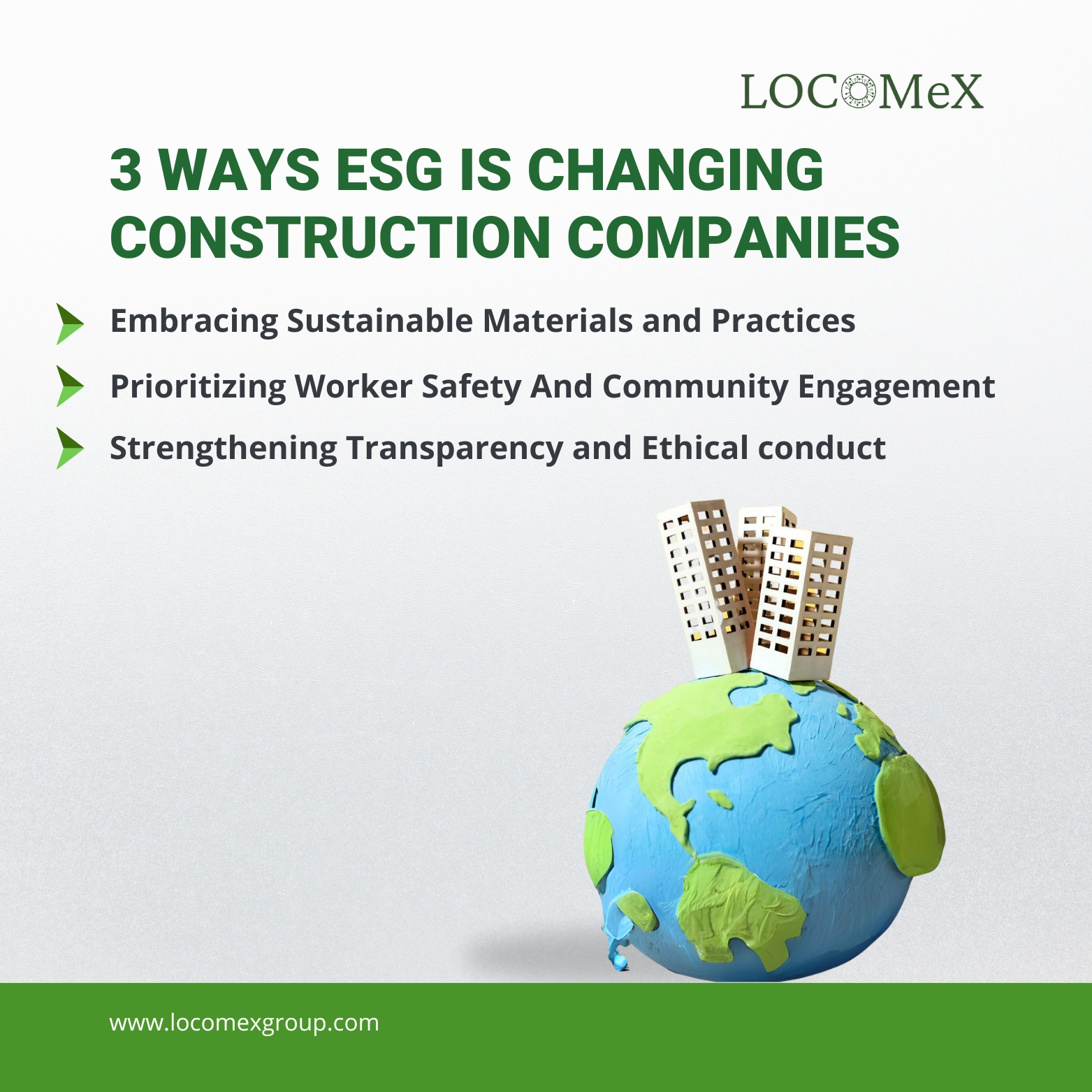221
The construction of towering skyscrapers and sprawling infrastructure that define our world comes with a hidden cost. While construction is crucial for economic growth, its traditional methods leave a bad trail of environmental impact and devastation.
Given the resources, energy, and waste involved, each stage in a building project has a long-term impact. As a result, an increasing number of stakeholders and clients want construction businesses to adhere to ESG standards in the construction sector. This means implementing green building practices, utilizing renewable energy sources, and prioritizing worker safety. By focusing on sustainable construction practices, construction businesses can build responsible building practices.
Now, let us delve into one such company called
Crescent Companies, which is actively involved in ensuring compliance across various aspects of diversity and sustainability in the construction industry. Keep reading to explore the challenges they encounter and how LOCOMeX’s tools can help overcome these challenges in the construction sector.
Key Takeaways
- ESG is reshaping construction for sustainability and ethics.
- Green materials and energy-efficient designs lead the change.
- Construction firms aim for positive environmental and social impacts.
- Embrace ESG and technology for a brighter future in construction.
Challenges In Construction Companies And How To Overcome It
Challenge 1: Lack of Standardized ESG Metrics
Crescent Companies may encounter difficulties in measuring and reporting ESG performance. This lack of standardization makes it challenging to assess the effectiveness of sustainability efforts accurately and compare performance across different projects and companies.
Solution: Implementing LOCOMeX’s Supplier-Based ESG Scoring Tool addresses this challenge by providing standardized metrics and frameworks for evaluating and benchmarking ESG performance. By adopting consistent measurement standards, Crescent Companies can gain clarity and ensure transparency in their sustainability reporting.
Challenge 2: Difficulty in Tracking Diverse Suppliers
Crescent Companies may struggle with manual or fragmented processes for tracking diverse suppliers across various projects and operations. This can result in inefficiencies, inconsistencies, and delays in data collection, analysis, and reporting.
Solution: LOCOMeX’s Supplier Pylon offers a centralized solution for tracking diverse suppliers. Through its “AI-First” supplier registration and onboarding approach, it can connect diverse Suppliers with opportunities with the highest chances of succeeding.
Challenge 3: Ensuring Compliance with Evolving Regulations
Complying with environmental and social regulations is a major challenge for Crescent Companies, as noncompliance can lead to legal risks, reputational damage, and financial penalties.
Solution: LOCOMeX’s local content (Buy America) compliance may provide Crescent Companies with real-time updates on relevant environmental and social regulations. By staying informed and proactive, it can ensure compliance with all applicable laws and standards, mitigating risks and maintaining its reputation as a construction company.
Challenge 4: Balancing Sustainability Goals with Project Profitability
Crescent Companies may face the ongoing challenge of balancing their sustainability goals with project profitability. Investments in sustainable practices may incur additional costs or require changes to traditional construction methods, potentially impacting project budgets and timelines.
Solution: LOCOMeX’s ESG Metrics solutions
offer insights and strategies to help Crescent Companies optimize sustainability practices while maintaining project profitability. Identifying cost-effective, sustainable solutions and integrating them into project planning and execution processes can enhance both environmental impact and financial performance.

ESG Integration In Construction Companies
1. Embracing Sustainable Materials and Practices
Reduced environmental impact: Traditional construction relies heavily on resource-intensive materials like concrete and steel. ESG encourages construction companies to explore alternatives like recycled content, locally sourced materials, and prefabricated components. This minimizes greenhouse gas emissions, carbon emissions from transportation and reduces waste generation.
Energy-Efficient Design: Buildings are major energy consumers. Modern design practices promoted by ESG principles focus on energy efficiency. It includes incorporating features like high-performance insulation, rainwater harvesting systems, energy-efficient windows, and smart building technology systems. These innovative solutions not only benefit the environment but also lead to substantial cost savings for building owners and occupants.
2. Prioritizing Worker Safety and Community Engagement
Enhanced Worker Well-being: People are still at the center of construction, from the workers who start the project to the surrounding community after the structure is completed. Providing safe surroundings, equal remuneration, and opportunity for skill development is not only ethically required but also results in better project outcomes.
Positive Community Relations: Construction projects often impact local communities. ESG promotes proactive engagement with residents, businesses, and local authorities. It can involve holding open forums, addressing noise concerns, and implementing measures to minimize disruption during construction.
3. Strengthening Transparency and Ethical Conduct
Responsible Material Sourcing: ESG principles advocate for the responsible sourcing of sustainable building materials. This means that companies are increasingly verifying their claims by assessing the sustainability reports of their suppliers and ensuring ethical practices throughout their supply chains. It not only minimizes environmental impact but also helps mitigate reputational risks.
Sustainable Project Management: ESG promotes efficient project management practices that minimize resource depletion and better water consumption. It might involve implementing recycling programs on reusing materials, utilizing digital tools for better renewable resources, and focusing on waste reduction strategies throughout the project lifecycle.
Build Better Future Today With ESG Initiatives
So far, the current impact of ESG on construction is undeniable. It is driving innovation and shaping a more sustainable development. As awareness and regulatory bodies around ESG continue to evolve, its influence on construction practices will only become more significant. Companies that embrace ESG principles today will be well-positioned to thrive in this evolving landscape.
LOCOMeX is at the forefront of this change. Our cloud-based platform empowers construction companies to integrate ESG into their operations seamlessly. Join us in building a more sustainable future for construction.
Frequently Asked Questions (FAQs)
What is ESG in the construction industry?
In construction, ESG stands for Environmental, Social, and Governance. It’s a framework for building practices that minimize environmental impact, prioritize worker well-being and community engagement, and ensure ethical conduct for the project teams.
What are the principles of ESG integration?
The principles involve considering three key areas:
Environmental: Minimizing resources like water consumption, reducing emissions, and using sustainable materials.
Social: Ensuring worker safety, fair labor practices, and positive community engagement.
Governance: Implementing transparent practices, ethical sourcing, and responsible project management.
Why do ESG companies perform better?
ESG companies are seen as performing better for a few reasons:
Reduced Risks: They proactively manage environmental and social issues, potentially avoiding costly fines or disruptions.
Long-term Focus: ESG practices often lead to resource efficiency and cost savings, benefiting the company’s bottom line.
Investor Appeal: Investors increasingly favor companies demonstrating ESG commitment, leading to better access to capital.
What is the difference between ESG and sustainability?
ESG is a specific framework for measuring a company’s performance on ESG issues. Sustainability refers to responsible practices that meet present needs without compromising future generations. In simpler terms, ESG is a tool to assess sustainability.




